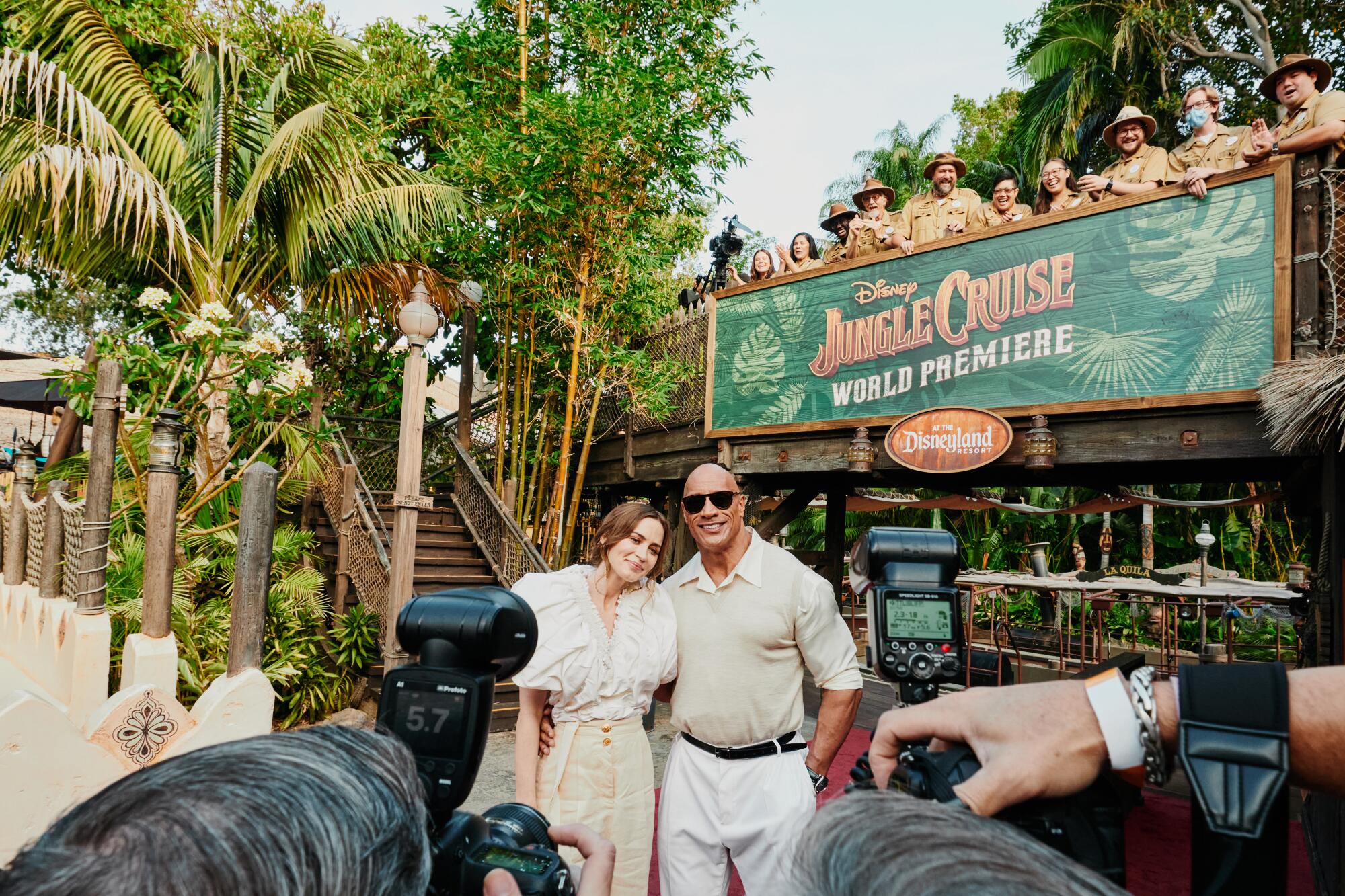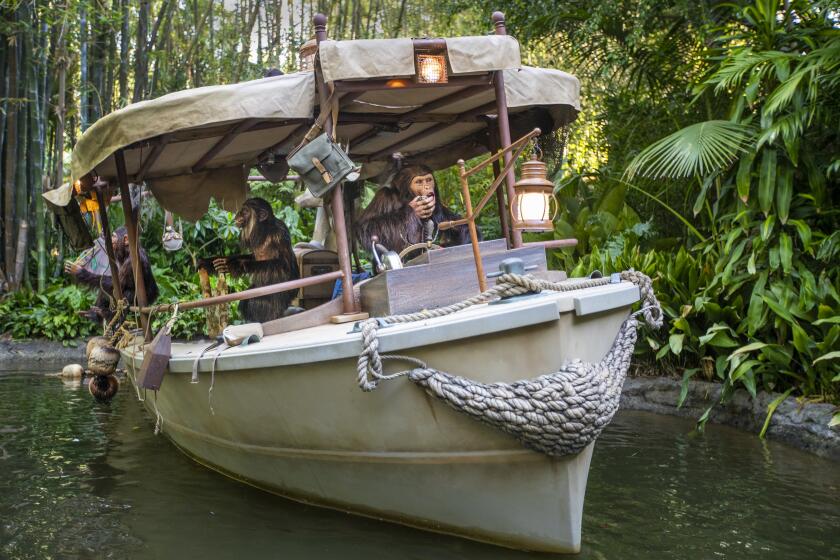
- Share via
A single Instagram post in 2017 caused a momentary panic in the Disney community.
Dwayne Johnson, standing in front of a Herb Ryman-drawn map of the initial proposal for Disneyland, stated that he and his production company were partnering with Walt Disney Imagineering — the secretive division of the company responsible for theme park experiences — to “reengineer and redesign” the Jungle Cruise ride, one of Disneyland’s opening-day attractions.
Updates to the ride were, of course, long overdue, as numerous scenes contained offensive tribal caricatures crafted through a colonialist lens. Johnson’s Jungle Cruise vision was unknown, and while the attraction, overseen by Walt Disney, had undergone numerous changes over six decades — most designed to add more humor and creatures — would a robotic Rock be on the horizon?
Not quite. Or at least not yet, as the combined box office and Disney+ grosses of the Johnson and Emily Blunt-starring film “Jungle Cruise” will likely determine the audio-animatronic possibilities at Disney’s parks around the world. For now, at least, nods to the action-focused blockbuster-hopeful with a mystical, “Raiders of the Lost Ark”-influenced tone remain subtle and of the more hidden, “Easter egg” variety in the Disneyland original.
The new Jungle Cruise shows Disney wants to be in the cultural conversation rather than an artifact or, worse, a representation of the ‘good ole days.’
“When you meet these behind-the-scenes heroes, it’s an extraordinary experience,” says Johnson of his time at Imagineering, before offering an ever-so-slight tease that more tweaks could be on the horizon. “Hopefully, there’s parts of our movie that might influence the ride just a little bit going forward.”
It wouldn’t be the first time Disneyland’s Jungle Cruise has taken inspiration from cinema. The original attraction was sprung from Disney’s own nature documentaries as well as the 1951 classic “The African Queen,” starring Humphrey Bogart and Katharine Hepburn, which is also a clear influence on the big-screen “Jungle Cruise.” Starting Friday in theaters and on Disney+ premier access, audiences can see for themselves what a Johnson Jungle Cruise looks like in the Jaume Collet-Serra-directed film. If the ride is a leisurely, throwback antidote to modern thrill and special effects-laden attractions, the film aims to be exactly the opposite.
And this 2021 take on “Jungle Cruise” — rooted in the chemistry, bickering and exaggerated contradictions between Johnson’s cynical skipper Frank and Blunt’s idealistic botanist Lily — did present an opportunity to bring modern sensibilities to the Disneyland original.
The action-comedy adventure, filmed in Hawaii but located in a fictionalized Amazon, set out to course-correct some of the Jungle Cruise ride’s more uncomfortable aspects. Gone are implications of Westerners as superior colonizers, as well as grotesque depictions of Indigenous people as tourist attractions, attackers or cannibals. The villains here include an army of undead Spanish conquistadors who tried and failed to wield the jungle to their needs — namely, an attempt to raid a tree with healing powers.
“What we wanted to represent about the ride was that joy and nostalgia,” says Blunt. “It pierces your heart directly. But ... we want to represent it sensitively and respectfully.”
Over the last decade, Disney has been more aggressive about removing cultural stereotypes from its attractions. In 2017, Disneyland gave women agency in its Pirates of the Caribbean attraction by removing a bridal auction scene and reimagining a female “wench” as a pirate, and last year the company pledged to remake the “Song of the South”-referencing Splash Mountain into an attraction inspired by “The Princess and the Frog,” which stars the company’s first Black princess, Tiana.
You can’t see the jungle for the CGI in this action-adventure inspired by the long-running Disney theme-park attraction.
With a major Jungle Cruise-inspired film on the horizon, the timing was right to rethink the Disneyland original — known best for its animal vignettes, much of them crafted by Disney’s master animator-turned-Imagineer Marc Davis. The reimagined ride largely doubles down on slapstick-inspired scenes involving chimpanzees and monkeys getting the best of a prior Jungle Cruise expedition.
“From our talks with the Imagineers, what was so interesting is that they’ve been wanting to redo the ride for a long time,” says Beau Flynn, a producer on the film. “But it’s the most revered, and the most nostalgic, and no one would let them. Every generation wanted the same experience. So the Imagineers were like, ‘Thank God for this movie, because it gives the opportunity to make changes we’ve wanted to make.’”
The film has some clever solutions for some of the ride’s outmoded — and now removed — imagery. Spear-brandishing headhunters, for instance, are turned into a sly joke that plays with Western stereotypes. Screenwriter Michael Green (“Logan,” “Blade Runner 2049”), who joined the project in late 2017, said the filmmakers wanted to reframe some of the ride’s unsavory aspects, a benefit of cinema that one doesn’t get via the pure environmental storytelling in a theme park attraction.
The film’s natives are in a businesses partnership with Frank, and they too think their costumes are silly. “What we were able to do is poke fun at the tourist perception of a what a native is supposed to be, and then you realize the joke is on them,” Green says. “They’re more sophisticated and dignified than they were being credited for. There’s moments that played to that. They’re in on the scam.”
The film makes a number of additional progressive tweaks.
The character of Trader Sam, the tribesman who will trade “two of his heads for one of yours” was removed from the ride but lives on in “Jungle Cruise,” portrayed as a mysterious, entrepreneurial figure by Veronica Falcón.
And, in a moment sure to further the debate on how Disney handles its LGBTQ characters, the film contains a coming-out scene for Lily’s brother, MacGregor (Jack Whitehall), in conversation with Frank.
While not exactly subtle, the moment is not specifically direct either, as MacGregor notes that he was ostracized from much of his family for his romantic interests leaning “elsewhere.”
“I suggested a bunch of things,” Green says, “and one of them was, ‘What if Lily’s brother is with her, and what if he’s gay?’ Everyone said, ‘That sounds interesting. Let’s see where that takes us.’ It was in every draft of the script, and every cut, where MacGregor tells Frank that the reason he’s so dedicated to Lily is because she’s the one who stood by him when he came out, and for that he would follow her into a volcano. It’s one of the things I’m very proud of. I don’t consider it an oblique reference.
“There’s no question about it,” Green continues. “If he has a romantic interest in a hopeful sequel, it will be with a man. If we’re lucky enough to get to make another one, we’d all like to see MacGregor have a romance.”
If characters in “Jungle Cruise” are broadly drawn, that’s very much by design.
Blunt’s Lily, for instance, is presented as a hardened adventurer, and the mysteries of Johnson’s Frank are played down until a surprise reveal late in the film. In the modern era of filmmaking, where every detail tends to be overly explained, those working on “Jungle Cruise” say there are lessons to be learned from theme park attractions, where audiences are escorted from scene to scene and fill in the blanks via our imagination.
“We wanted to make sure we were honoring the ride, making sure it wasn’t too dark, but making sure it was humorous,” says producer Dany Garcia. “It’s very similar to the history of the Haunted Mansion [attraction], where you have multiple points of view. It was the same way for us.”
More to Read
Only good movies
Get the Indie Focus newsletter, Mark Olsen's weekly guide to the world of cinema.
You may occasionally receive promotional content from the Los Angeles Times.












